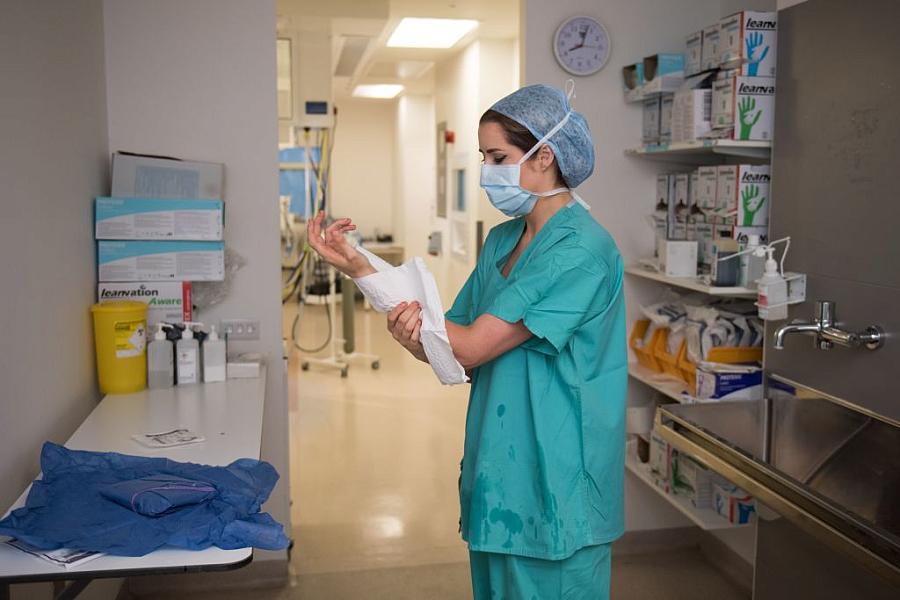How to start looking into poor workplace conditions at hospitals near you

(Photo: Oli Scarff/AFP/Getty Images)
When our health care workers suffer poor health because of their jobs, the system is weaker for all of us.
That’s why journalists should pay attention later this year when the Bureau of Labor Statistics releases its annual report on nonfatal injuries in the workplace. The data serve as an important backdrop for investigative reporting on health care injuries on hospitals, clinics, and specialty care settings in your coverage area.
A few years ago, Daniel Zwerdling at NPR drew attention to these data as part of an investigative series on health care workplace injuries. Zwerdling wrote in 2015:
Nursing employees have very likely been getting hurt moving and lifting patients for as long as there have been nurses and patients. But studies by the U.S. government and university researchers in the 1990s began showing that hospitals can prevent many of those injuries, if hospital administrators invest enough time and money. They have to buy special equipment to move patients, such as powered ceiling hoists, and they have to conduct intensive training for the staff.
There are signs that hospitals and nursing homes are making changes to protect nurses and other workers. When last year’s report came out on health care injuries, some of the same numbers that Zwerdling had highlighted were trending in the right direction. The bureau wrote that workplace injuries in health care settings led to 600 fewer cases of people spending days away from work in 2017 (the latest year of available statistics), down from 23,570 cases in 2016, meaning a 2% decrease. That’s not a dramatic drop, but it’s respectable in one year.
What are hospitals and nursing homes near you doing to protect their workers?
First, it’s helpful to know what kinds of threats are common in the health care workplace. The U.S. Centers for Disease Control and Prevention has a good breakdown that includes “sharps injuries, harmful exposures to chemicals and hazardous drugs, back injuries, latex allergy, violence, and stress.”
To find out locally, you should ask them. Have them explain to you what kinds of investments they have made in worker safety over the past five years and then ask what investments they have made, for example, in new diagnostic equipment that will help bring in more revenue by finding problems that can then be treated at the hospital — regardless of whether the problems merit significant medical attention. (We know that more screening leads to more unnecessary treatment, and there is limited evidence that additional screening for most diseases is effective.)
Health care workplaces are often regulated by multiple agencies, and so you are likely able to find out if something dangerous is taking place through multiple channels. The Albert Einstein College of Medicine in New York City lists 12 different federal, state and local agencies that regulate health care work place safety — just for New York. Some of these regulatory agencies are obvious. Others might surprise you, like the Nuclear Regulatory Commission, a federal agency best known for monitoring nuclear reactors.
Why is the latter involved?
Because hospitals and other health care workplaces often make use of radioactive materials. And, if they’re not careful, they can put their workers, patients, and the public at risk. Here’s one recent example of a notice of violation issued by the NRC in February 2019 to Providence Alaska Medical Center:
Specifically, prior to August 2018, the PAMC failed to properly monitor personnel exposures, resulting in three contract occupational workers potentially exceeding the … annual limit. PAMC also failed to implement elements of its radiation protection program to review and evaluate abnormal radiation exposure reports, investigate exposure reports with results over licensee-set administrative limits, develop recommendations to management for corrective action, and implement effective corrective actions to restore compliance.
For additional help with understanding trends in workplace safety for health care, you used to be able to turn to the Occupational Health Safety Network (OSHN), which was created in 2012 to track health care worker safety. OSHN helped reveal in 2018, for example, that “Workplace violence is a serious, increasingly common problem in OHSN-participating hospitals.”
But OSHN was “retired” on September 30, 2019 without so much as a decent obituary. Anyone know why? Let me know via Twitter @wheisel.
